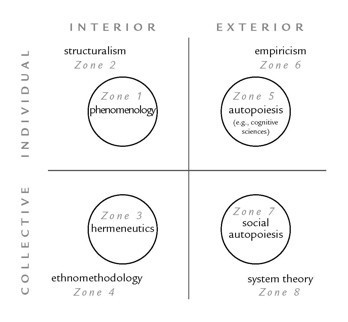All Zones: Different Ways of Knowing
In addition to the five elements of integral theory, which comprise the basic foundation of the AQAL model, there is an another more advanced aspect that is important to mention. This aspect is less of a new element and more of a complexification of the first one (the quadrants). Each of the perspectives associated with the four quadrants can be studied through two major methodological families, namely from either the inside (i.e., a first-person perspective) or the outside (i.e., a third-person perspective). This results in eight distinct zones of human inquiry and research.
These eight zones comprise what integral theory calls integral methodological pluralism (IMP), which includes such approaches as phenomenology (an exploration of first-person subjective realities), ethnomethodology (an exploration of second-person intersubjective realities), and empiricism (an exploration of third-person empirical realities). Figure 12 includes all eight zones and their respective labels. IMP represents one of the most pragmatic and inclusive theoretical formulations of any integral or meta-theoretical approach. It gives the integral practitioner assurance that they are using tried and true methods of investigation that human ingenuity has produced over the last 2000 years.

Figure 12. Eight methodological zones.
Integral methodological pluralism operates according to three principles: inclusion (consult multiple perspectives and methods impartially), enfoldment (prioritize the importance of findings generated from these perspectives), and enactment (recognize that phenomenon are disclosed to subjects through their activity of knowing it). As a result of these commitments, integral theory emphasizes the dynamic quality of realities as being enacted through a subject using a particular method to study an object. That object can be a first-, second-, or third-person reality. For example, we can study first-person psychological realities as an object of investigation just as easily as we can study third-person biological realities.
Because integral theory acknowledges and includes all the major insights from valid forms of research, it emphasizes the importance of including all zones in its efforts to understand anything in a comprehensive way. It uses the IMP framework as a way to marshal, coordinate, and assess pertinent perspectives and their research findings. To return to our integral hiker, IMP provides her with multiple ways of interacting with and knowing the landscape she is traveling through. Her compass, binoculars, book of edible plants, early morning meditations, and previous wildlife encounters all provide her with different ways of knowing the wilderness in ways that are meaningful and valuable to her as a hiker and nature lover.
Among the many important perspectives on reality, there are schools of thought that specialize in using the methods, practices, and techniques associated with each zone. Consequently, in addition to the five elements presented above, an integral approach must include all eight zones or it risks leaving out important aspects of reality that have a bearing on effective solutions to the problems facing our communities and our planet. In other words, the more of reality we acknowledge and include, the more sustainable our solutions will become, precisely because a project will respond more effectively to the complexity of that reality. We cannot exclude major dimensions of reality and expect comprehensive, sustainable results. Eventually those realities that have been excluded will demand recognition and incorporation as the design falters and is abandoned for more nuanced and comprehensive strategies. Hence the need for an integral approach.
An integral practitioner is constantly combining first-, second-, and third-person methods, practices, and techniques in an effort to research the many essential aspects of a given situation. Performing such integral research, either through informal or formal means, the practitioner is engaged in integral methodological pluralism. This kind of integral mixed methods orientation is extremely valuable because it allows practitioners to often discover surprising relationships between first-, second-, and third-person realities that later become essential links in their designs and solutions. Through IMP, integral practitioners are often able to identify valuable connections between distinct realities that have yet to be identified or leveraged in previous efforts. Thus, equipped with the eight major forms of knowledge acquisition developed by humanity, the integral practitioner is well positioned to know the complexity and depth of reality and to place that insight into service for self, culture, and nature. The reason an integral practitioner can use this wide assortment of formal methods in the first place is that they are actively engaged in using all of these methods informally in their own embodied awareness. In fact, each major methodological family (e.g., empiricism or hermeneutics) is simply a formalized version of something we do naturally all the time. For example, our ability to take a third-person perspective on the world around us (e.g., looking at the flowers growing along the sidewalk) is the basis for empiricism and our ability to take a second-person perspective with our friends (e.g., talking to them about why they want to quit their job) is the basis for hermeneutics. Consequently, the eight zones of IMP is simply a reminder of the many ways we know ourselves, others, and the world around us. The integral framework allows us to coordinate these multiple ways of knowing and place them into orchestrated action in the world.


